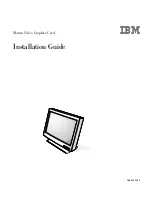
PCI-DIO48(S)(S) Manual
Page 1-2
Manual 00650-529-1
The PCI-DIO48(S)S card was designed for industrial applications and can be installed in 7", or
longer, PCI slots of IBM or compatible computers. Each I/O line is buffered and capable of
sourcing 15 mA or sinking 24mA (64 mA on request). The card contains two Programmable
Peripheral Interface chips type 8255-5 (PPI) to provide computer interface to 48 I/O lines. Each
PPI provides three 8-bit ports A, B, and C. Each 8-bit port can be software configured to function
as either inputs or output latches. Port C can also be configured as four inputs and four output
latches. Pull-ups on the card assure that there are no erroneous outputs at power up until the card
is initialized by system software.
Tristate I/O line buffers (74LS245) are configured automatically by hardware logic for input or
output use according to direction assignment from a control register in the PPI. Further, if a
jumper is properly placed on the card, the tristate buffers may be enabled/disabled under program
control. (See the Option Selection section to follow.)
I/O wiring connections are via 50-pin headers on the board. Two flat I/O cables connect
PCI-DIO48(S)S to termination panels. Also, this provides compatibility with OPTO-22, Gordos,
Potter & Brumfield, et al module mounting racks. Every second conductor of the flat cables is
grounded to minimize crosstalk between signals in the cables. If needed for external circuits, +5
VDC power is available on each I/O connector pin 49. If you use this power, we recommend that
you include a 1A fast-blow fuse in your circuits in order to avoid possible damage to the host
computer or cable in the event of a malfunction in those external circuits.
The PCI-DIO48(S)S occupies sixteen bytes of I/O address space. The base address is selected by
the system. An illustrated setup program is provided on diskette with the PCI-DIO48(S)S card.
Interactive displays show locations and proper settings jumpers to set up the interrupt enable
function. Also, sample programs in Turbo-C and Turbo-Pascal are presented in the Software
section of this manual.










































